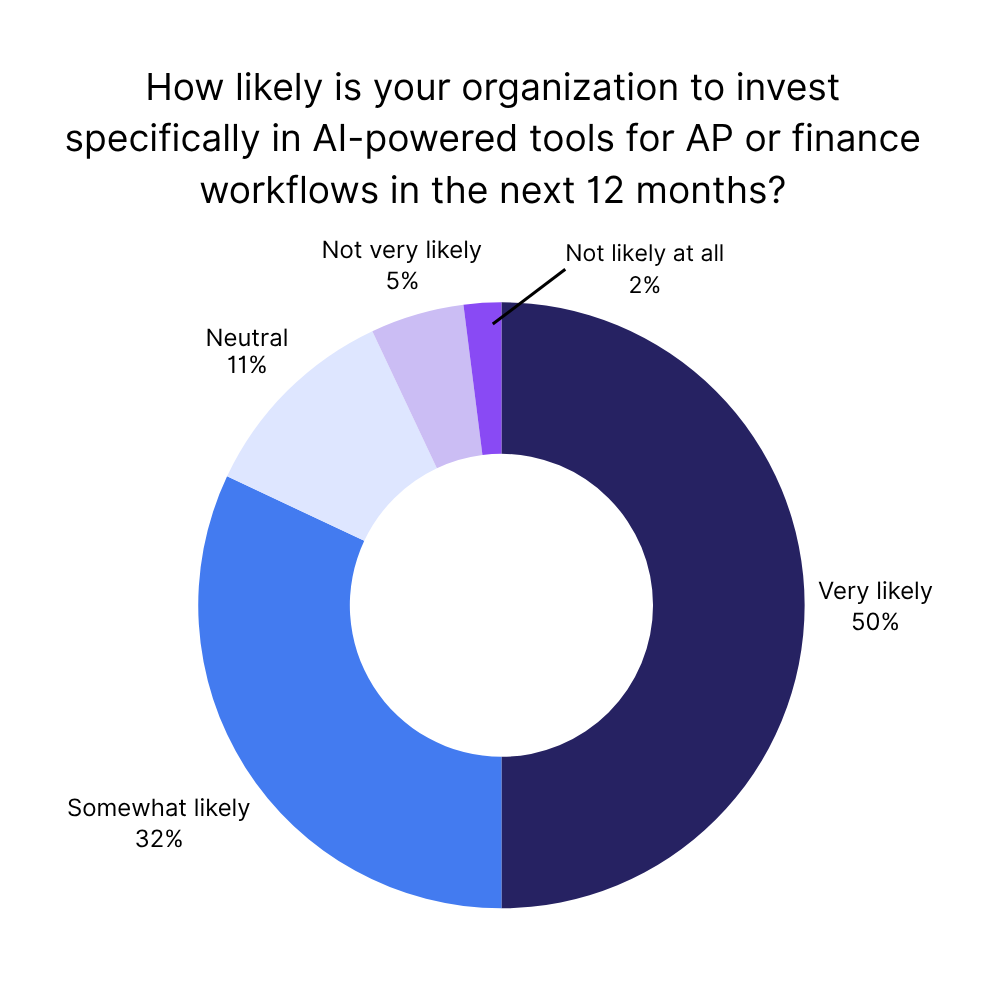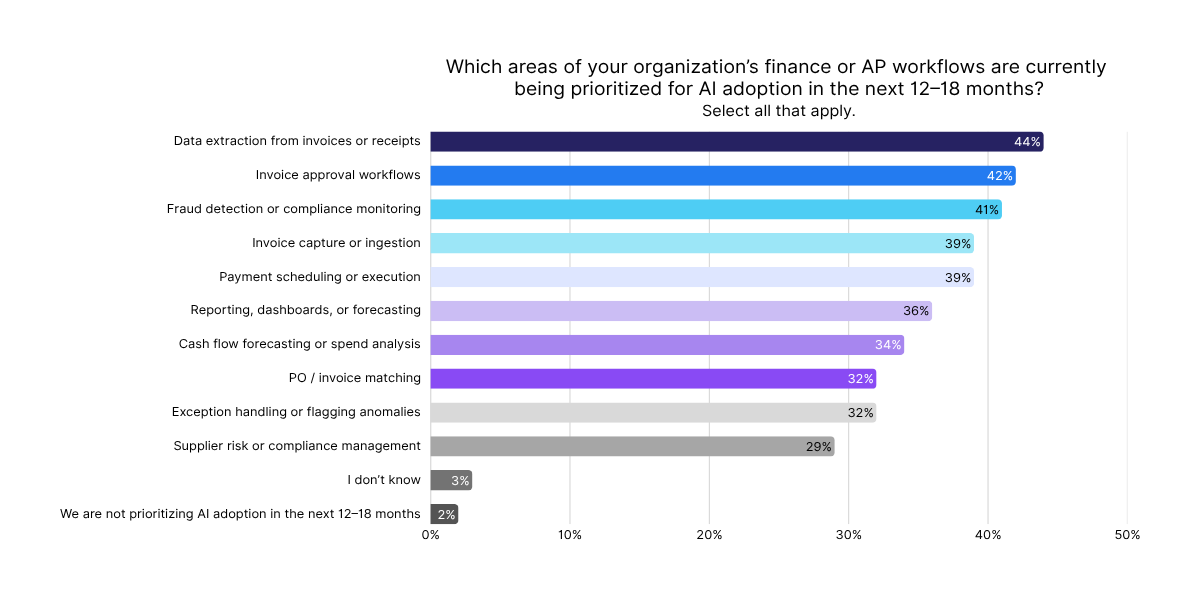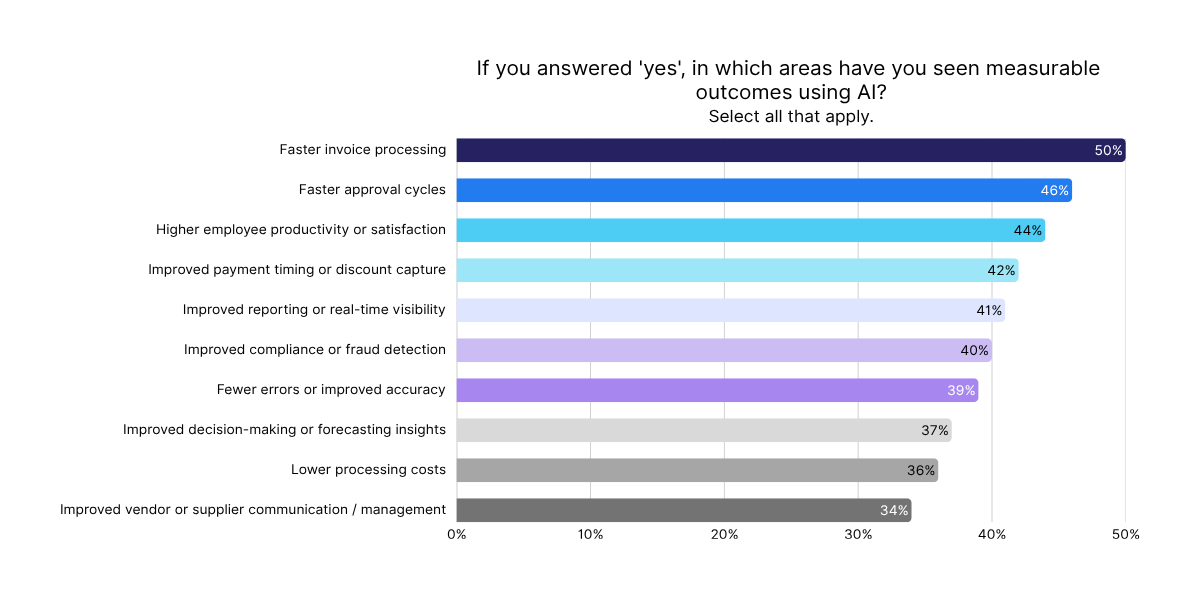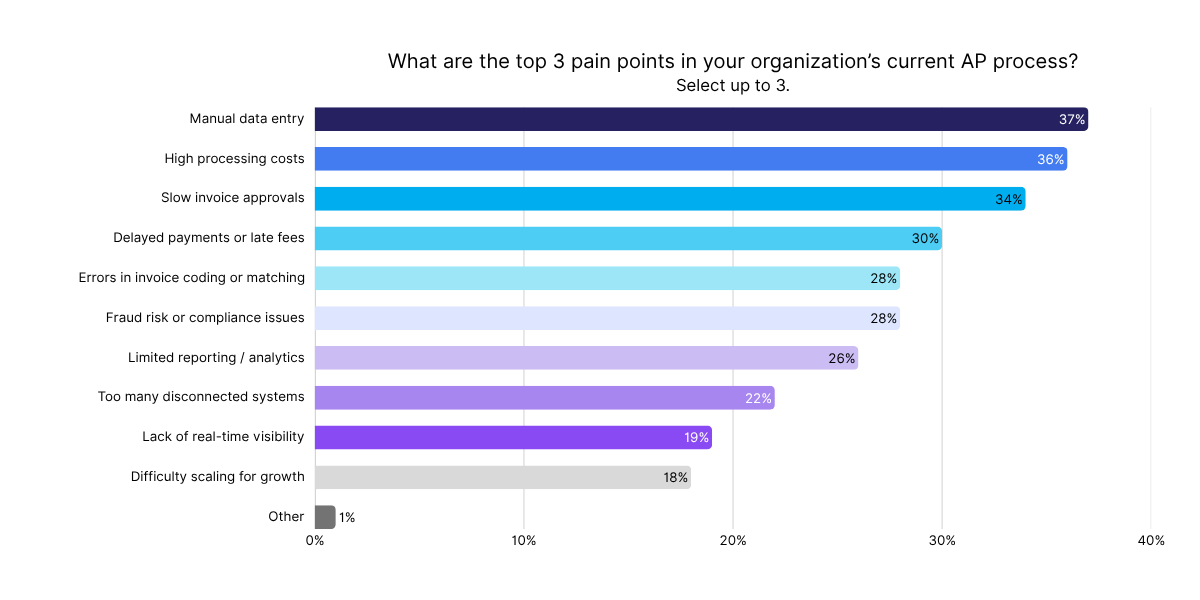
If 2025 was the year finance teams tested AI, 2026 is shaping up to be the year they start funding it. According to findings from the AI Momentum Report, 82% of finance and accounts payable (AP) leaders plan to invest in new AI capabilities over the next 12 months — a clear sign that experimentation is giving way to execution.
It’s a pivotal moment. After years of cautious pilots and selective automation, finance leaders are now putting real dollars behind AI. But where those budgets are going — and why AP continues to lead the way — says a lot about how finance is redefining its role in the business.
AP: Still the proving ground for finance AI
While AI has made its way into nearly every corner of the enterprise, finance has been deliberate about its entry points. AP, in particular, remains the most practical and data-rich starting place, and the results speak for themselves.
The AI Momentum Report found that 72% of organizations now use some form of AI, with workflow automation (58%), generative AI (53%), and data extraction (46%) topping the list of current use cases. These are the high-volume, rules-based workflows where the impact is clear: faster invoice processing, fewer manual touchpoints, and reduced risk of human error.
Other areas like invoice capture (40%) and fraud detection (40%) are close behind, demonstrating that finance teams aren’t just using AI for efficiency, but also to strengthen accuracy, compliance, and control.
In short, AI in AP has evolved from “nice-to-have automation” to a core operational layer. That success is now shaping how the rest of finance approaches adoption.
Finance is following IT’s cloud adoption curve
A decade ago, IT leaders faced a similar inflection point with cloud computing. What began as a series of isolated pilots soon became a strategic imperative. The same pattern is unfolding in finance today, just with AI as the driver.
Right now, just over half of organizations using AI are scaling or optimizing it, while the rest remain in pilot mode. That balance looks almost identical to where IT stood in the early days of cloud adoption: widespread interest, but uneven maturity.
The takeaway for CFOs? Momentum builds fast once ROI is proven. Just as IT teams moved from cost-saving use cases to full-scale cloud transformation, finance is poised to expand beyond invoice processing into predictive forecasting, spend analytics, and real-time insight generation.
And much like IT learned with cloud, those who invest early in the right foundation will be best positioned to scale later.
Early budget signals show a shift in mindset
When 82% of leaders plan new investments, that’s not just a technology story — it’s a budgeting one. The AI Momentum Report shows clear signals that finance is moving from “experimenting with AI” to operationalizing it.
Early adopters are already carving out dedicated AI line items in their finance budgets. The focus areas are clear:
- Workflow automation and intelligent document processing
- Predictive analytics for forecasting and cash flow
- Fraud detection and compliance monitoring
- Generative AI for reporting and documentation

The common thread across these investments? Scale. Finance teams aren’t looking for one-off tools; they’re building connected AI ecosystems that integrate seamlessly with ERP systems and existing workflows.
That foundation is already in place for many: 91% of respondents report at least partial ERP integration with automation tools, meaning finance operations are primed for the next wave of advanced automation.
The value Is real — measurable outcomes from AI in finance
Early adopters aren’t just investing in AI; they’re now seeing tangible returns. Among survey respondents already using AI, 79% report measurable benefits, proving that value is not theoretical; it’s being realized today.
The most common outcomes include:
- Faster invoice processing (50%)
- Faster approvals (46%)
- Improved employee satisfaction (44%)
- Better payment timing or discount capture (42%)
- Improved reporting (41%)

These results highlight both operational and experiential improvements — automation not only makes processes faster, it also makes teams’ work easier and more fulfilling.
Meanwhile, lower processing costs (36%) and vendor or supplier improvements (34%) show that financial and external-facing benefits are emerging but have room to grow. For CFOs, these figures reinforce a clear message: AI delivers value that can be measured, communicated, and scaled across the finance function.
For CFOs, the message Is clear: waiting Is the risk
As investment intent rises, so does competitive pressure. In today’s market, waiting to act may carry more risk than moving early.
The report found that despite growing adoption, 37% of organizations still cite manual data entry as their top operational challenge, and 36% point to high processing costs. These inefficiencies highlight the opportunity gap between early AI leaders and those still stuck in pilot mode.

CFOs who want to close that gap should focus on three priorities:
1. Build scalable infrastructure. Prioritize AI platforms that connect seamlessly with existing finance systems rather than standalone apps.
2. Establish governance early. Define clear KPIs for AI performance and embed ethical, auditable frameworks.
3. Invest in skills. Equip teams to manage and interpret AI outputs — not just use them.
The next phase of finance transformation will depend on how effectively leaders can align strategy, data, and technology around measurable outcomes.
AI in finance is moving from promise to proof
If there’s one takeaway from the AI Momentum Report, it’s that AI is no longer a future vision, it’s a current investment priority. Finance leaders are no longer asking if AI will deliver value; they’re asking how fast they can prove it.
As budgets shift toward scaling, the real differentiator won’t just be who implements AI, but who realizes value fastest. The most successful finance teams will be those that can move from deployment to measurable impact in weeks — not quarters.
That’s where accounts payable offers a blueprint. AP has already demonstrated how automation can quickly reduce processing time, improve accuracy, and free up capacity. The next step is applying those same lessons to broader finance functions — forecasting, compliance, and spend visibility — where faster insights translate directly into better decisions and financial control.
For CFOs, this is the new north star: build AI that scales and delivers quick, trackable ROI. Every investment needs a clear business case, a defined success metric, and a roadmap for value realization.
Because in 2026, speed to value will separate early AI leaders from those still fine-tuning their pilots. And with 82% of finance leaders planning new AI investments in the year ahead, one thing is certain: those who pair ambition with measurable impact won’t just automate faster — they’ll lead smarter, sooner.
Download the complete AI Momentum Report to see where finance teams are investing next and how leaders are turning AI ambition into measurable, fast-returning value.











.svg)
